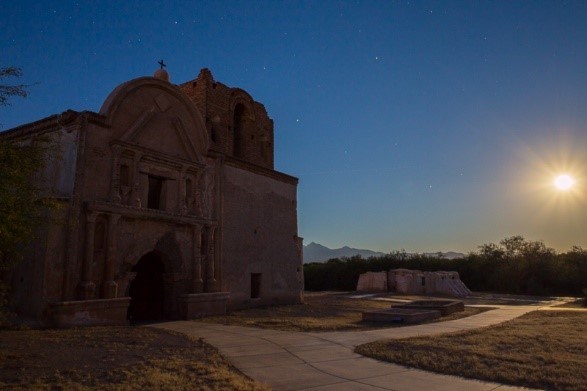Learn about NRCAs
The Natural Resource Condition Assessment (NRCA) Program provides framework, funding, and publishing support to parks to aid in the synthesis and documentation of natural resource conditions. Condition assessment reports are a tool to describe selected park resources, and record a snapshot of their current condition, identify trends, and identify potential or current threats and stressors. Understanding the condition and trend of natural resources is key for parks and NPS planners to appropriately prioritize and allocate stewardship resources.

NPS/Gene Rimmer.
Due to the wide range in elevations and its position between the Neotropic influence of the Sierra Madre Mountains to the south and the Nearctic influence of the Rocky Mountains to the north, the Apache Highlands South Ecoregion contains a striking variety of habitat types and associated wildlife. Vegetation at Tumacácori National Historical Park consists of cottonwood-willow riparian forest and woodland lining the Santa Cruz River channel, velvet mesquite bosque (forest) and woodland on the low terraces bordering the channel, with a transition to savanna, semidesert grassland, and desert (mesquite) scrub on the uplands away from the river.
Traditional NRCA Report: 2019
In an effort to better understand the natural resources and processes found in this park, a Natural Resource Condition Assessment was written and published in 2019. This assessment was a collaborative effort between Tumacácori National Historical Park staff and Utah State University. The assessment was published in 2019 and evaluated the current condition of the park’s ten natural resources of most interest to park management:
- Hydrology |
||
- Water quality |
||
- Air quality |
||
- Upland vegetation and soils |
||
- Riparian vegetation |
||
- Mammals |
||
- Birds |
||
- Fish |
||
- Herpetofauna |
||
- Bats |
The majority of resources were found to be of moderate concern, except for the wildlife resources — birds, bats and mammals — which were in good condition. The condition of herpetofauna could not be determined due to lack of current data. Like many national parks throughout the United States, the resource conditions at Tumacácori National Historical Park are vulnerable to stressors far beyond its borders, such as warming temperatures, variable and intense precipitation events, and surrounding land use changes. Managing the park’s natural resources in light of current and rapidly changing environmental conditions, such as increasing temperatures, decreasing precipitation, and increasing populations of non-native species is challenging, but paramount to resource preservation. Establishing partnerships with surrounding land managers and private citizens provides opportunities for achieving shared conservation goals.
For other reports and natural resource datasets visit the NPS Data Store.
Source: NPS DataStore Collection 7765 (results presented are a subset). To search for additional information, visit the NPS DataStore.
Last updated: August 16, 2022
